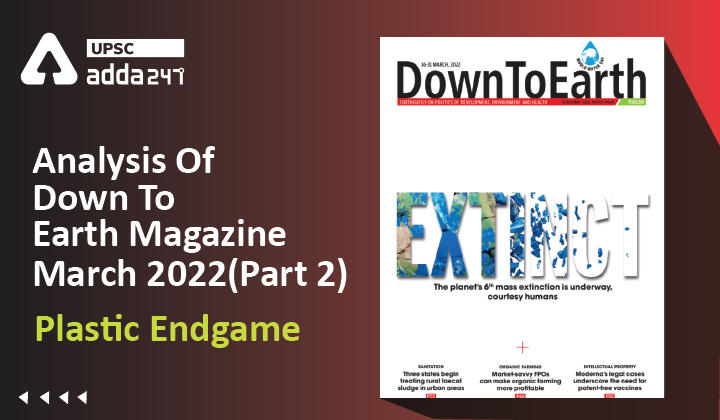Table of Contents
Analysis Of Down To Earth Magazine: ”Plastic Endgame”
Relevance
GS 3: Environmental Pollution & Degradation
Introduction
- Recently, the world passed 14 resolutions at the resumed session of the fifth United Nations Environment Assembly (UNEA), held in Nairobi, Kenya, between February 28 and March 2, 2022.
- The most crucial of these was the decision to establish an intergovernmental negotiating committee that will forge a legally binding agreement to end plastic pollution.
What is the Plan?
- World leaders plan to start negotiations on this resolution in June.
- If the timeline is kept, this will be the second-fastest environmental agreement to move from the adoption stage into negotiations.
- This highlights the urgency of the problem and the global commitment to address it.
- The proposed committee has the ambitious task of drafting an agreement on plastics by the end of 2024 when the leaders plan to meet for the sixth Assembly.
Why is it a Difficult Task?
- The treaty on ending plastic pollution, which includes microplastics and marine litter, will have both binding and voluntary approaches.
- The resolution indicates that the committee has to include provisions promoting national and international cooperative measures and national action plans to work towards the prevention, reduction and elimination of plastic pollution.
- It will also specify arrangements for capacity building, technical assistance, technology transfer and financial assistance.
- The resolution indicates the possibility of a global fund and invites governments and other stakeholders to provide budgetary resources.
- The fund will ensure countries and economies in transition that deal with a large fraction of plastic waste, especially in the global south, are supported by nations whose plastic production and waste generation are high.
What are the Limitations?
- While the resolution calls for strict action to curb the entire life cycle of plastics, it is silent on whether the agreement will look at the oil, gas or coal sectors that are responsible for the raw materials used to make plastics.
- Currently, 99 per cent of plastics are produced from petrochemicals and experts expect fierce resistance from the petrochemical industry, which is not happy with the resolution.
- In India, the share price of Reliance Industries fell as the news of the global plastic treaty spread across the country. The company holds a 42 per cent stake in the Indian plastic ecosystem.
- Since the agreement invites all relevant stakeholders, including the industries, there will be attempts to insert half-baked solutions like chemical recycling (plastic to fuel) and incineration (including co-incineration) in the final text.
What GOI is doing?
- In January, India released new guidelines under its extended producer responsibility (EPR) norms that introduced the concept of plastic credits for the industry.
- Under this, companies have a liability to collect plastic waste equivalent to the amount they generate in a year.
- Further, if a company collects plastic waste in addition to what it generates, it can sell the extra as credit to companies that are not collecting enough plastic waste.
- The policy has piqued the interest of consumer goods companies who are using it to greenwash their brands and avoid accountability.
- Dabur, one of India’s largest consumer goods companies, in February started claiming it was plastic neutral just by fulfiling its EPR liability.



 TSPSC Group 1 Question Paper 2024, Downl...
TSPSC Group 1 Question Paper 2024, Downl...
 TSPSC Group 1 Answer key 2024 Out, Downl...
TSPSC Group 1 Answer key 2024 Out, Downl...
 UPSC Prelims 2024 Question Paper, Downlo...
UPSC Prelims 2024 Question Paper, Downlo...




